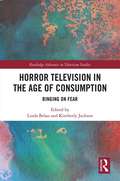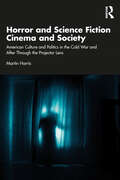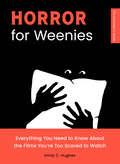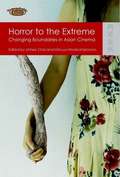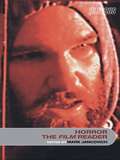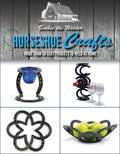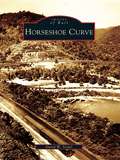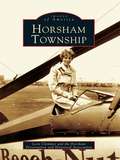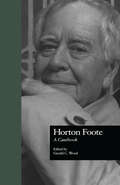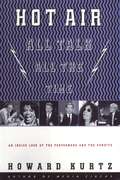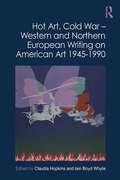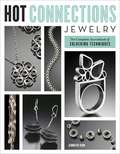- Table View
- List View
Horror Noire: A History of Black American Horror from the 1890s to Present
by Robin R. Means ColemanFrom King Kong to Candyman, the boundary-pushing genre of horror film has always been a site for provocative explorations of race in American popular culture. This book offers a comprehensive chronological survey of Black horror from the 1890s to present day. In this second edition, Robin R. Means Coleman expands upon the history of notable characterizations of Blackness in horror cinema, with new chapters spanning the 1960s, 2000s, and 2010s to the present, and examines key levels of Black participation on screen and behind the camera. The book addresses a full range of Black horror films, including mainstream Hollywood fare, art-house films, Blaxploitation films, and U.S. hip-hop culture-inspired Nollywood films. This new edition also explores the resurgence of the Black horror genre in the last decade, examining the success of Jordan Peele’s films Get Out (2017) and Us (2019), smaller independent films such as The House Invictus (2018), and Nia DaCosta’s sequel to Candyman (2021). Means Coleman argues that horror offers a unique representational space for Black people to challenge negative or racist portrayals, and to portray greater diversity within the concept of Blackness itself. This book is essential reading for anyone seeking to understand how fears and anxieties about race and race relations are made manifest, and often challenged, on the silver screen.
Horror Noire: Blacks in American Horror Films from the 1890s to Present
by Robin R Means ColemanFrom King Kong to Candyman, the boundary-pushing genre of the horror film has always been a site for provocative explorations of race in American popular culture. In Horror Noire: Blacks in American Horror Films from 1890's to Present, Robin R. Means Coleman traces the history of notable characterizations of blackness in horror cinema, and examines key levels of black participation on screen and behind the camera. She argues that horror offers a representational space for black people to challenge the more negative, or racist, images seen in other media outlets, and to portray greater diversity within the concept of blackness itself. Horror Noire presents a unique social history of blacks in America through changing images in horror films. Throughout the text, the reader is encouraged to unpack the genre’s racialized imagery, as well as the narratives that make up popular culture’s commentary on race. Offering a comprehensive chronological survey of the genre, this book addresses a full range of black horror films, including mainstream Hollywood fare, as well as art-house films, Blaxploitation films, direct-to-DVD films, and the emerging U.S./hip-hop culture-inspired Nigerian "Nollywood" Black horror films. Horror Noire is, thus, essential reading for anyone seeking to understand how fears and anxieties about race and race relations are made manifest, and often challenged, on the silver screen.
Horror Television in the Age of Consumption: Binging on Fear (Routledge Advances in Television Studies)
by Kimberly Jackson Linda BelauCharacterized as it is by its interest in and engagement with the supernatural, psycho-social formations, the gothic, and issues of identity and subjectivity, horror has long functioned as an allegorical device for interrogations into the seamier side of cultural foundations. This collection, therefore, explores both the cultural landscape of this recent phenomenon and the reasons for these television series’ wide appeal, focusing on televisual aesthetics, technological novelties, the role of adaptation and seriality, questions of gender, identity and subjectivity, and the ways in which the shows’ themes comment on the culture that consumes them. Featuring new work by many of the field’s leading scholars, this collection offers innovative readings and rigorous theoretical analyses of some of our most significant contemporary texts in the genre of Horror Television.
Horror after 9/11
by Aviva Briefel Sam J. MillerHorror films have exploded in popularity since the tragic events of September 11, 2001, many of them breaking box-office records and generating broad public discourse. These films have attracted A-list talent and earned award nods, while at the same time becoming darker, more disturbing, and increasingly apocalyptic. Why has horror suddenly become more popular, and what does this say about us? What do specific horror films and trends convey about American society in the wake of events so horrific that many pundits initially predicted the death of the genre? How could American audiences, after tasting real horror, want to consume images of violence on screen? Horror after 9/11 represents the first major exploration of the horror genre through the lens of 9/11 and the subsequent transformation of American and global society. Films discussed include the Twilight saga; the Saw series; Hostel; Cloverfield; 28 Days Later; remakes of The Texas Chainsaw Massacre, Dawn of the Dead, and The Hills Have Eyes; and many more. The contributors analyze recent trends in the horror genre, including the rise of ‘torture porn,’ the big-budget remakes of classic horror films, the reinvention of traditional monsters such as vampires and zombies, and a new awareness of visual technologies as sites of horror in themselves. The essays examine the allegorical role that the horror film has held in the last ten years, and the ways that it has been translating and reinterpreting the discourses and images of terror into its own cinematic language.
Horror and Science Fiction Cinema and Society: American Culture and Politics in the Cold War and After Through the Projector Lens
by Martin HarrisExamining how horror and science fiction films from the 1950s to the present invent and explore fictional “us-versus-them” scenarios, this book analyzes the different ways such films employ allegory and/or satire to interrogate the causes and consequences of increasing polarization in American politics and society.Starting with the killer ants film with an anti-communist subtext Them! (1954) and concluding with Jordan Peele’s social horror film with revenge-seeking homicidal doppelgängers Us (2019), Martin Harris highlights social and political contexts, contemporary reviews and responses, and retrospective evaluations to show how American horror and science fiction films reflect and respond to contemporary conflicts marking various periods in U.S. history from post-WWII to the present, including those concerning race, gender, class, faith, political ideology, national identity, and other elements of American society.Horror and Science Fiction Cinema and Society draws upon cinematic sociology to provide a resourceful approach to American horror and science fiction films that integrates discussion of plot construction and character development with analyses of the thematic uses of conflict, guiding readers’ understanding of how filmmakers create otherworldly confrontations to deliver real-world social and political commentary.
Horror for Weenies: Everything You Need to Know About the Films You're Too Scared to Watch
by Emily C. HughesA smart, funny crash course in 25 iconic horror movies, from Psycho to Hereditary, for people who love getting the reference but hate being scared.You don't have to miss out just because you don't like to be frightened! Stop trying to read nonsensical Wikipedia plot summaries (we know you&’re doing it), and let an expert tell you everything you need to know about the most influential horror films of the past 60 years—without a single jump scare or a drop of gore.With a rundown of the history and significance of horror cinema, explanations of common tropes, and detailed entries on 25 important movies ranging from Night of the Living Dead to The Blair Witch Project to Get Out, Horror for Weenies will turn even the scarediest of cats into a confident connoisseur.Each entry includes: A detailed plot summary, with enough jokes that it won&’t freak you outSmart, illuminating analysis of the film&’s themes and cultural significance Descriptions of iconic scenes you definitely do not want to look at Talking points for impressing even the biggest scary-movie buffsHorror for Weenies is the first installment in the Outsider&’s Guide series, which offers highly readable crash courses in major cultural phenomena, so you can catch the references and understand the big deal. Never get left out of a conversation again!
Horror in Architecture: The Reanimated Edition
by Joshua Comaroff Ong Ker-ShingA new edition of this extensive visual analysis of horror tropes and their architectural analogues Horror in Architecture presents an unflinching look at how horror genre tropes manifest in the built environment. Spanning the realms of art, design, literature, and film, this newly revised and expanded edition compiles examples from all areas of popular culture to form a visual anthology of the architectural uncanny. Rooted in the Romantic and Gothic treatment of horror as a serious aesthetic category, Horror in Architecture establishes incisive links between contemporary horror media and its parallel traits found in various architectural designs. Through chapters dedicated to distorted and monstrous buildings, abandoned spaces, extremes of scale, and other structural peculiarities, and featuring new essays on insurgent natures, blobs, and architectural puppets, this volume brings together diverse architectural anomalies and shows how their unsettling effects deepen our fascination with the unreal. Intended for both horror fans and students of visual culture, Horror in Architecture turns a unique lens on the relationship between the human body and the artificial landscapes it inhabits. Extensively illustrated with photographs, film stills, and diagrams, this book retrieves horror from the cultural fringes and demonstrates how its attributes permeate the modern condition and the material world.
Horror to the Extreme
by Jinhee Choi Mitsuyo Wada-MarcianoThis book compares production and consumption of Asian horror cinemas in different national contexts and their multidirectional dialogues with Hollywood and neighboring Asian cultures. Individual essays highlight common themes including technology, digital media, adolescent audience sensibilities, transnational co-productions, pan-Asian marketing techniques, and variations on good vs. evil evident in many Asian horror films. Contributors include Kevin Heffernan, Adam Knee, Chi-Yun Shin, Chika Kinoshita, Robert Cagle, Emilie Yeh Yueh-yu, Neda Ng Hei-tung, Hyun-suk Seo, Kyung Hyun Kim, and Robert Hyland.
Horror's New Wave: 15 Years of Blumhouse
by BlumhouseCelebrate legendary horror studio Blumhouse&’s legacy with this lavishly illustrated visual compendium that takes you behind the scenes of the films that have reshaped the horror genre, from The Exorcist to the Paranormal Activity and Halloween franchises.With Blumhouse celebrating its 15th anniversary throughout 2025, Horror&’s New Wave captures the company&’s journey to become a powerhouse in the horror and thriller film genres—taking you through the process of conception to premiere for films like Five Nights at Freddy&’s, Sinister, Split, Get Out, M3GAN, now-classic franchises like The Purge, and so much more. This definitive &“Blumhouse book&” delves into the behind-the-scenes processes that shaped Blumhouse&’s iconic films and is perfect for cinephiles, pop culture enthusiasts, and lovers of horror. Featuring an introduction from CEO and founder Jason Blum, it also includes interviews with key filmmakers and writers like M. Night Shyamalan, Leigh Whannell, James Wan, and Mike Flanagan; actors, such as Allison Williams, Ethan Hawke, Jamie Lee Curtis, and Octavia Spencer; and Blumhouse executives like head of film Couper Samuelson and head of casting Terri Taylor. These interviews explore how each project came together, offering stories and insights into the creative process, such as directing, musical score, makeup, acting, cinematography, and more. You will get a birds-eye view at the triumphs and challenges of some of the most beloved and iconic horror films of all time. This book also includes film stills, on-set photographs, storyboards, creative briefs, and title treatments—giving you a true backstage pass to the making of your favorite films.
Horror, The Film Reader (In Focus: Routledge Film Readers)
by Mark JancovichHorror, The Film Reader brings together key articles to provide a comprehensive resource for students of horror cinema. Mark Jancovich's introduction traces the development of horror film from The Cabinet of Dr. Caligari to The Blair Witch Project, and outlines the main critical debates. Combining classic and recent articles, each section explores a central issue of horror film, and features an editor's introduction outlining the context of debates.
Horror-Gami (Origami Books)
by Joost LangeveldPaper has never been so horrifying!Be bored nevermore, nevermore! A little piece of paper is hardly anything to be afraid of. But ordinary paper springs to life—and death!—with Horror-Gami, a new sophisticated origami kit for advanced origami artists. Create 20 origami projects: a vampire, Frankenstein, a black cat, a skull, a bat, a creepy hand, a mummy, a skeleton, a spider, a zombie, the Grim Reaper, an owl, a spooky tree with a raven on the branch, a werewolf, a raven, an axe, a ghost, a witch, and a headless horseman.Have no fear with these easy-to-follow instructions.Great fun for the entire family.Horror-Gami offers a new look at the ancient art of origami and paper crafting.
Horrors of a Voice (object a): Vox-Exo
by Tristam AdamsThis book reframes the Lacanian object a voice as a horrific register of alterity. The object gaze has received, as it does in Jacques Lacan’s work, more commentary than voice. Yet recently voice has garnered interest from multiple disciplines. The book intervenes in the Slovenian school’s commentary of the ‘object voice’ in terms of two questions: audition and corporeality. This intervention synthesizes psychoanalysis with recent theorizing of the horror of philosophy. In this intervention the object a voice is argued to resonate in lacunae – epistemological voids that evoke horror in the subject. Biological and evolutionary perspectives on voice, genre horror film and literature, music videos, close readings of Freudian and Lacanian case studies and textual analysis of ancient philosophy texts all contribute to an elucidation of the horrors of the object a voice: Vox-Exo.
Horse & Buggy Paint It Out! (I Like to Read)
by Ethan LongGeisel medalist Ethan Long's comical duo, Horse and his friend Buggy, get creative in this funny Level G reader, perfect for first graders.&“That&’s looks fun!&”&“Yes, I am painting a mural!&”Horse is all set to paint a mural his way, oblivious to Buggy's suggestions that a bit of planning might be a good idea. But as the Horse knocks over paint cans and sends brushes flying, he relents and accepts some help from Buggy.The duo's hilarious antics, easy-to-read text, and colorful cartoon illustrations will put smiles on the faces of fledgling readers.For early-to-mid first grade readers, Level G books feature more complex storylines than prior levels, and a wider variety of structure and punctuation. Illustrations offer support for decoding the more challenging vocabulary words introduced.The award-winning I Like to Read® series focuses on guided reading levels A through G, based upon Fountas and Pinnell standards. Acclaimed author-illustrators--including winners of Caldecott, Theodor Seuss Geisel, and Coretta Scott King honors--create original, high quality illustrations that support comprehension of simple text and are fun for kids to read with parents, teachers, or on their own!
Horse Breeds of North America: The Pocket Guide to 96 Essential Breeds
by Judith DutsonAn amazing variety of horse breeds roam North America’s vast and geographically diverse landscape. This detailed portable handbook celebrates the unique qualities of 96 regional breeds, from the sleek muscles of racing thoroughbreds and the stoic power of draft horses to the easy gait of pleasure horses at your local farm. Fascinating facts about each horse breed’s size, talents, and suitability for various types of work are accompanied by full-color photographs in this fun and informative reference guide.
Horseshoe Crafts: More Than 30 Easy Projects to Weld at Home
by Barbie The WelderThe sturdy metal of horseshoes meets exciting home crafting in this inventive book. Horseshoe Crafts provides thirty welding projects for you to try at home, whether you are a beginning welder or a more experienced crafter. Author and expert horseshoe crafter Barbie the Welder walks you through the steps. Providing introductory chapters on welding safety and introductory basics, Horseshoe Crafts enables you to learn the skills you’ll need to begin to make fantastic art and décor from new or used horseshoes. In this book, you’ll find step-by-step projects, a list of what tools you’ll need, and instructions on how to set your machines, as well as guidelines on how to finish up a variety of projects such as wine racks, paper towel holders, bowls, and picture frames. Additionally, included are tips on creating a host of outdoor ornaments such as wind chimes, flower pot holders, crosses, and more for décor that will be a welcome addition anywhere. Richly photographed and filled with step-by-step instructions, Horseshoe Crafts will help you weld an array of fun and inventive home furnishings.
Horseshoe Curve
by David W. SeidelThe Horseshoe Curve is known worldwide as an engineering achievement by the Pennsylvania Railroad. This landmark, located just west of Altoona, opened to traffic on February 15, 1854, and it enabled a railroad line to climb the Allegheny Mountains and the eastern continental divide. The Horseshoe Curve's construction impacted railroad design and development for mountainous terrain everywhere, enabling access to coal and other raw materials essential for the industrial age. J. Edgar Thomson, chief engineer of the Pennsylvania Railroad, is widely recognized for his engineering and design of the Horseshoe Curve, a concept never utilized previously. Today the curve is still in use and sees approximately 70 trains daily. Through vintage photographs, Horseshoe Curve chronicles how this marvel remains one of the vital transportation arteries linking the east and west coasts of the United States.
Horsham Township
by Horsham Preservation and Historical Association Leon ClemmerHorsham Township began as a farming and residential community. Today, the Willow Grove Naval Air Station is Horsham's largest employer and its most recognized feature. The predecessor of the air station was the Pitcairn Airfield. Here, Harold Pitcairn built the Mailwing airplane, delivered airmail along the East Coast, formed Eastern Air Lines, developed the Autogiro, and entertained celebrities such as Charles Lindbergh and Amelia Earhart. Photographs in Horsham Township show the Quaker meetinghouse, which is the oldest religious building in Horsham and is still in continuous use; the highways that served the township farmers, such as Limekiln Pike, York Road, and Easton Road; and the trolley cars from Doylestown to Willow Grove that connected the township to Philadelphia.
Horton Foote: A Casebook (Casebooks on Modern Dramatists #24)
by Gerald C. WoodFirst Published in 1998. Routledge is an imprint of Taylor & Francis, an informa company.
Hosting the Olympic Games: The Real Costs for Cities
by John Rennie ShortHosting the Olympic Games reveals the true costs involved for the cities that hold these large-scale sporting events. It uncovers the financing of the Games, reviewing existing studies to evaluate the costs and benefits, and draws on case study experiences of the Summer and Winter Games from the past forty years to assess the short- and long-term urban legacies for host cities. Written in an easily accessible style and format, it provides an in-depth critical analysis into the franchise model of the International Olympic Committee (IOC) and offers an alternative vision for future Games. This book is an important contribution to understanding the consequences for the host cities of Olympic Games.
Hot Air: All Talk, All the Time
by Howard KurtzAmerica is awash in talk. Loud talk, angry talk, conspiratorial talk that has changed the nature of journalism and politics, producing a high-decibel revolution in the way we communicate. In this fascinating, maddening, behind-the-scenes look at America's powerful talk shows, the author of Media Circus examines their excesses, conflicts, and impact, and explains how they are changing our culture.
Hot Art, Cold War – Southern and Eastern European Writing on American Art 1945-1990
by Claudia HopkinsHot Art, Cold War – Southern and Eastern European Writing on American Art 1945-1990 is one of two text anthologies that trace the reception of American art in Europe during the Cold War era through primary sources. Translated into English for the first time from sixteen languages and introduced by scholarly essays, the texts in this volume offer a representative selection of the diverse responses to American art in Portugal, Italy, Spain, Greece, Yugoslavia, Romania, Bulgaria, Soviet Union (including the Baltic States), Czechoslovakia, Poland, Hungary, and East Germany (GDR). There was no single European discourse, as attitudes to American art were determined by a wide range of ideological, political, social, cultural and artistic positions that varied considerably across the European nations. This volume and its companion, Hot Art, Cold War – Northern and Western European Writing on American Art 1945-1990, offer the reader a unique opportunity to compare how European art writers introduced and explained contemporary American art to their many and varied audiences. Whilst many are fluent in one or two foreign languages, few are able to read all twenty-five languages represented in the two volumes. These ground-breaking publications significantly enrich the fields of American art studies and European art criticism.
Hot Art, Cold War – Southern and Eastern European Writing on American Art 1945-1990
by Iain Boyd Whyte Claudia HopkinsHot Art, Cold War – Southern and Eastern European Writing on American Art 1945-1990 is one of two text anthologies that trace the reception of American art in Europe during the Cold War era through primary sources.Translated into English for the first time from sixteen languages and introduced by scholarly essays, the texts in this volume offer a representative selection of the diverse responses to American art in Portugal, Italy, Spain, Greece, Yugoslavia, Romania, Bulgaria, Soviet Union (including the Baltic States), Czechoslovakia, Poland, Hungary, and East Germany (GDR). There was no single European discourse, as attitudes to American art were determined by a wide range of ideological, political, social, cultural and artistic positions that varied considerably across the European nations.This volume and its companion, Hot Art, Cold War – Northern and Western European Writing on American Art 1945-1990, offer the reader a unique opportunity to compare how European art writers introduced and explained contemporary American art to their many and varied audiences.Whilst many are fluent in one or two foreign languages, few are able to read all twenty-five languages represented in the two volumes. These ground-breaking publications significantly enrich the fields of American art studies and European art criticism.
Hot Art, Cold War – Western and Northern European Writing on American Art 1945-1990: Western and Northern European Writing on American Art 1945 to 1990
by Claudia HopkinsHot Art, Cold War – Northern and Western European Writing on American Art 1945-1990 is one of two text anthologies that trace the reception of American art in Europe during the Cold War era through primary sources. With the exception of those originally published in English, the majority of these texts are translated into English for the first time from eight languages, and are introduced by scholarly essays. They offer a representative selection of the diverse responses to American art in Great Britain, Ireland, France, Belgium, the Netherlands, West Germany (FRG), Austria, Switzerland, Denmark, Norway, Sweden, and Finland. There was no single European discourse, as attitudes to American art were determined by a wide range of ideological, political, social, cultural and artistic positions that varied considerably across the European nations. This volume and its companion, Hot Art, Cold War – Southern and Eastern European Writing on American Art 1945-1990, offer the reader a unique opportunity to compare how European art writers introduced and explained contemporary American art to their many and varied audiences. Whilst many are fluent in one or two foreign languages, few are able to read all twenty-five languages represented in the two volumes. These ground-breaking publications significantly enrich the fields of American art studies and European art criticism.
Hot Connections Jewelry: The Complete Sourcebook of Soldering Techniques
by Jennifer ChinThe art of soldering--permanently joining metal components with a torch and solder--can open up a new world of creative possibilities for jewelry makers. In Hot Connections Jewelry, award-winning jewelry designer Jennifer Chin guides you through every step, from choosing a torch to basic techniques like sawing, filing, and riveting, as well as more advanced techniques like creating surface textures, setting stones, and using inlay. With 23 in-depth lessons and 15 stunning projects, as well as inspiring examples from contributing artists, Hot Connections Jewelry is your essential guide to unleashing your creativity and confidence in jewelry making. From the Trade Paperback edition.


